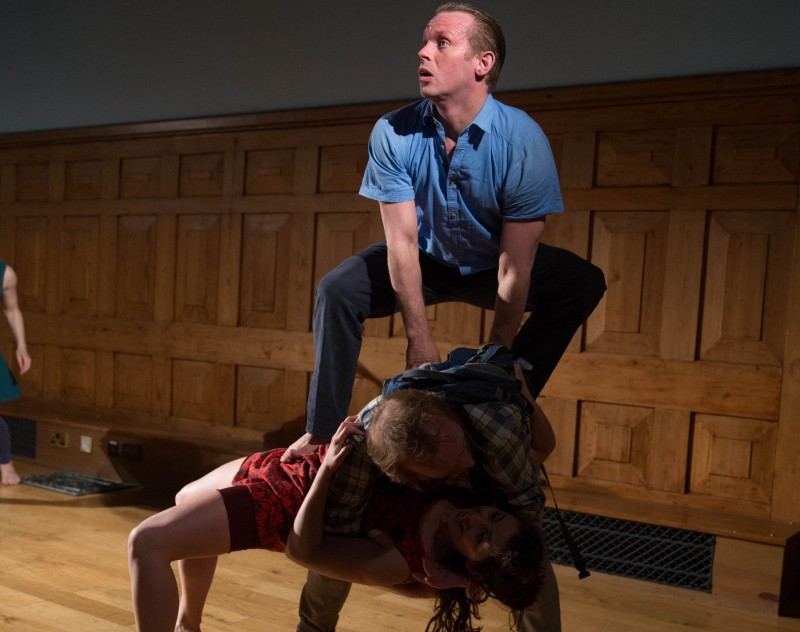 Close Distance’s vital portrayal of four neighbours has first-class choreography and dancing, a great storyline, not too over-inked, tangentially told with convincing dialogue, and a great soundtrack. It’s a full on 75 minutes that always has something catching the eye, the dance is compelling in that way that happens when dancers have fully invested in a character. At the beginning of the show a rather mousy-haired man with a small knapsack wanted to sit beyond us, then after talking to us about Yorkshire tea, climbed over the backs of the seats. ‘Nutter or performer,’ we thought. In the end the answer was both –he was a performer, the character was a bit of a nutter. It’s a device that works – throughout the performance the dancers occasionally return into the audience – we are their neighbours for the while after all.
Close Distance’s vital portrayal of four neighbours has first-class choreography and dancing, a great storyline, not too over-inked, tangentially told with convincing dialogue, and a great soundtrack. It’s a full on 75 minutes that always has something catching the eye, the dance is compelling in that way that happens when dancers have fully invested in a character. At the beginning of the show a rather mousy-haired man with a small knapsack wanted to sit beyond us, then after talking to us about Yorkshire tea, climbed over the backs of the seats. ‘Nutter or performer,’ we thought. In the end the answer was both –he was a performer, the character was a bit of a nutter. It’s a device that works – throughout the performance the dancers occasionally return into the audience – we are their neighbours for the while after all.
Each character is roundly portrayed – the first a woman who has been nervously looking though the porthole window in the door as the audience file in. Her self-absorbed song as she prepares and preens herself is otherworldly and domestic at the same time. Her movements, in a bright red dress, are rhythmic and brittle, full of ups and downs as she steps up to peer at herself, sometimes breaking into more posed dances as if she were practicing her moves for a party to come. It’s both very watchable in its own right, and neatly symbolic of her bird like character, full of chatter and movement. This same song irritates the salesman next door – a cue for his juxtaposed smiling announcements and retreats into a savage discontent as he hears her joyful trillings and is greatly disturbed by them. Later in the show her song is multitracked and becomes a full-on piece of music in its own right that fills the auditorium with strangely beautiful sound .
It’s the development of elements like these that gives Close Distance its full and satisfying roundness – Helen Parlor’s choreography never loses its step, the dancers fully inhabit their characters. The mousy-haired man agonises over the quiet woman at the opposite corner of the stage, his voice high and treble, his dancing (complete with shabby knapsack) full of rolls and contortions. The dancers perform all together, in pairs, individually, painting this picture of neighbours, and the tensions and desires that arise. It’s a spare set, but atmospherically lit, the doormats signifying the different houses entirely adequately, signature movements and dance signifying the different psyches inhabiting them. The confident man, let’s call him that, in his blue shirt and tie, alternates between a confident outward work pose, presenting and smiling, and the savagery of a contorted irritated home persona: you can see the tension building up as he listens to his neighbour singing.
All the dancers speak, though sparingly, and often in short clear articulate phrases that never quite complete the sentences they appear to start – it’s a very successful device that leaves the dance in the foreground, but adds enough sense and context to makes us feel we do know what is going on. There is a narrative arc of a kind, as they build up to a neighbourhood party, but it’s delicately stated and again underpins the dance without overwhelming it with too much certainty. The dancing is always the centrepiece, strong, vibrant and full of interest. Inventive too – the knapsack is used as well: dancers hang off its straps whirling its hapless man around, so that what appears to be his security, his safety shell, becomes the instrument of his torment and social connection simultaneously.
There is a gentleness in the characters’ portrayal such that it never descends into cliché or caricature – there is always a temptation to exaggerate traits so much that they become one dimensional, but Parlor Dance never give into to this shallowness. The quiet woman has her moments of strength and movement, at one time effortlessly holding one of the men in the air. The interactions are full of almost martial arts-type slidings across and over each other, like the mix of social patterns they represent. Overall the sense was of an hour and fifteen minutes packed with expressive and intensely watchable dance. It was a stunning display of movement, sound and narrative – far too hidden away in a mid-week, mid afternoon slot.
